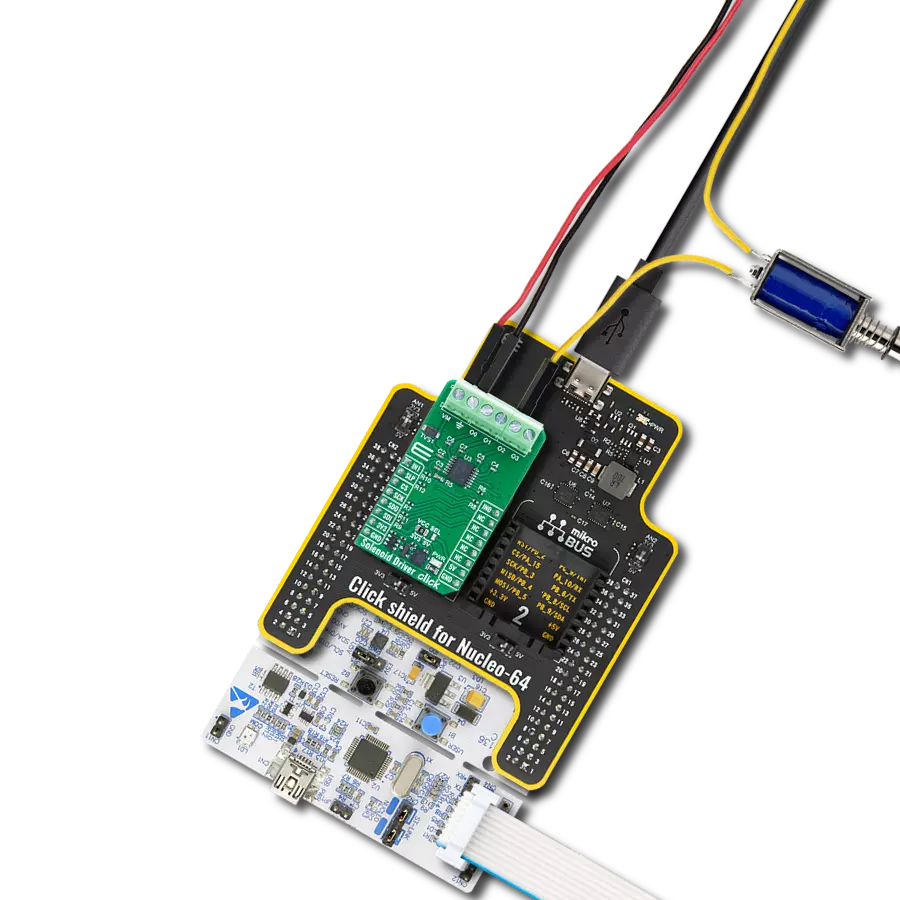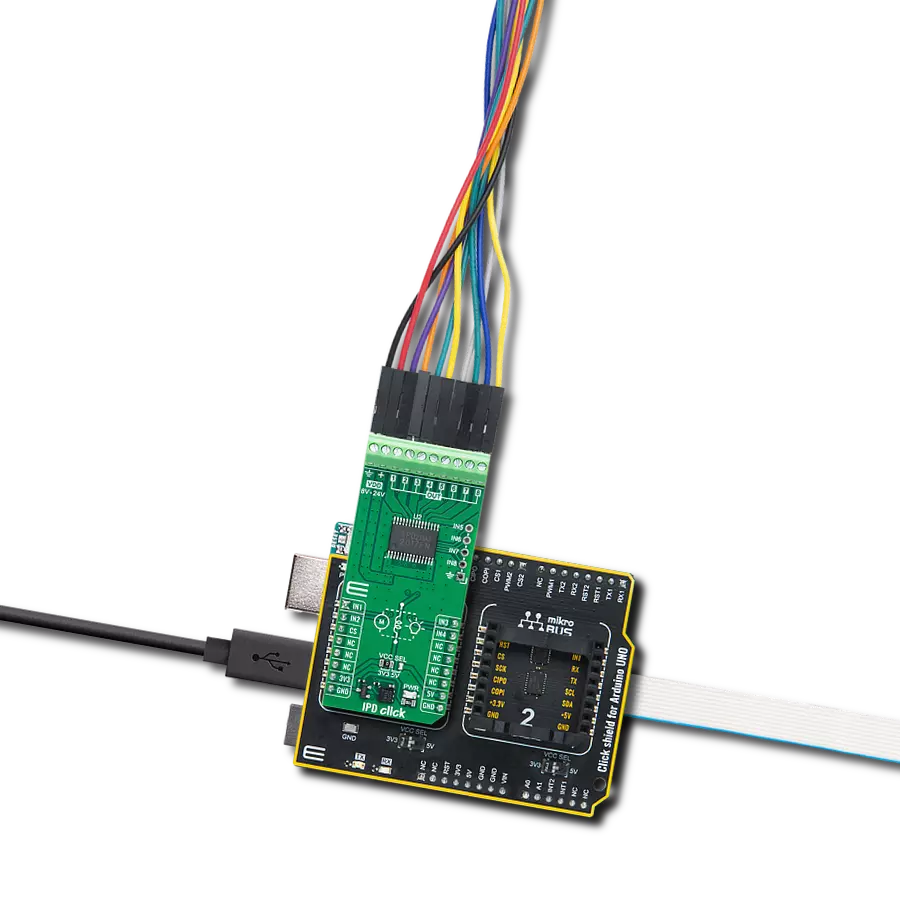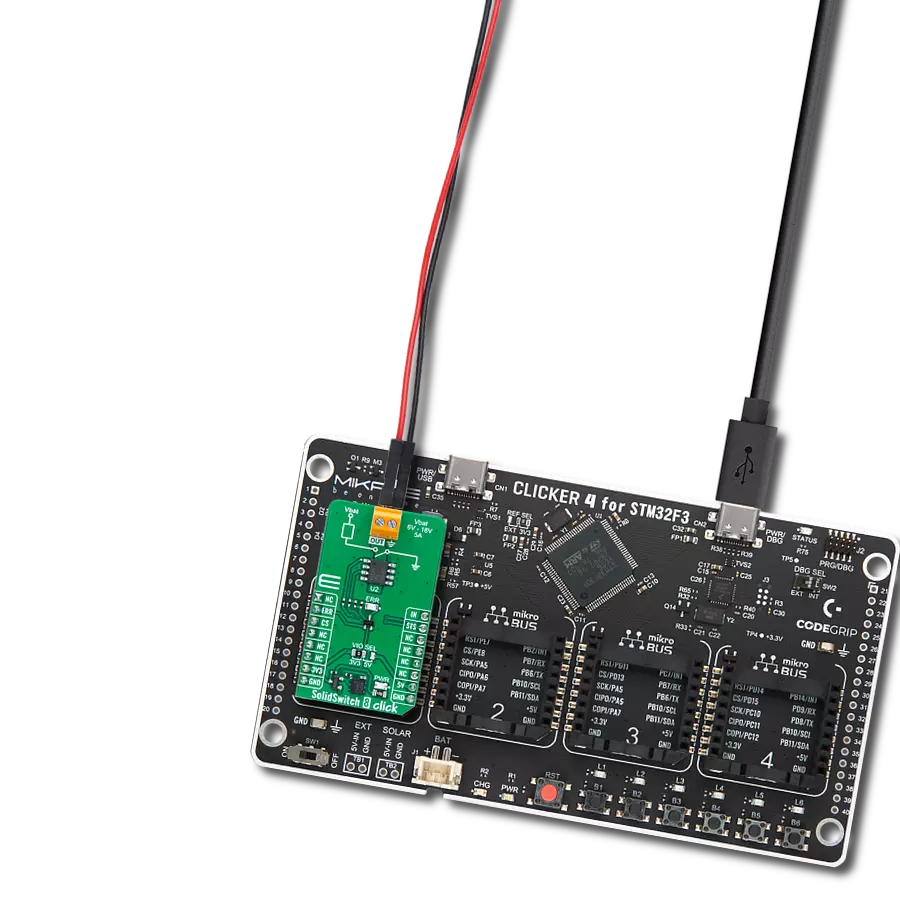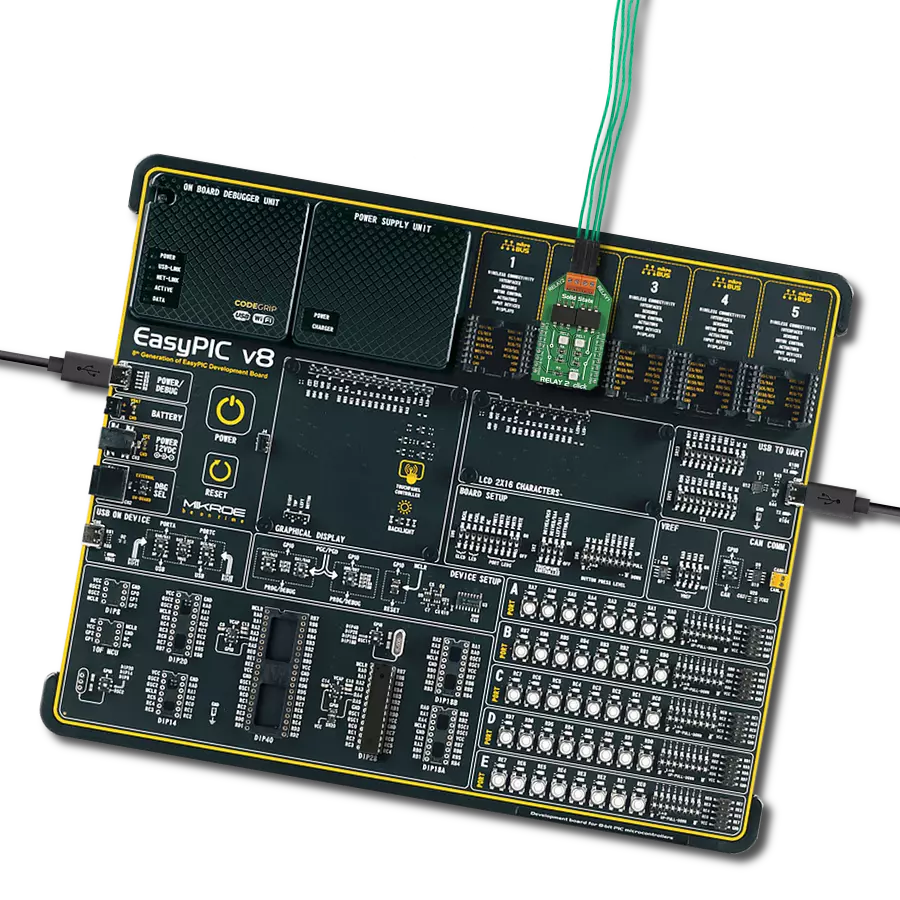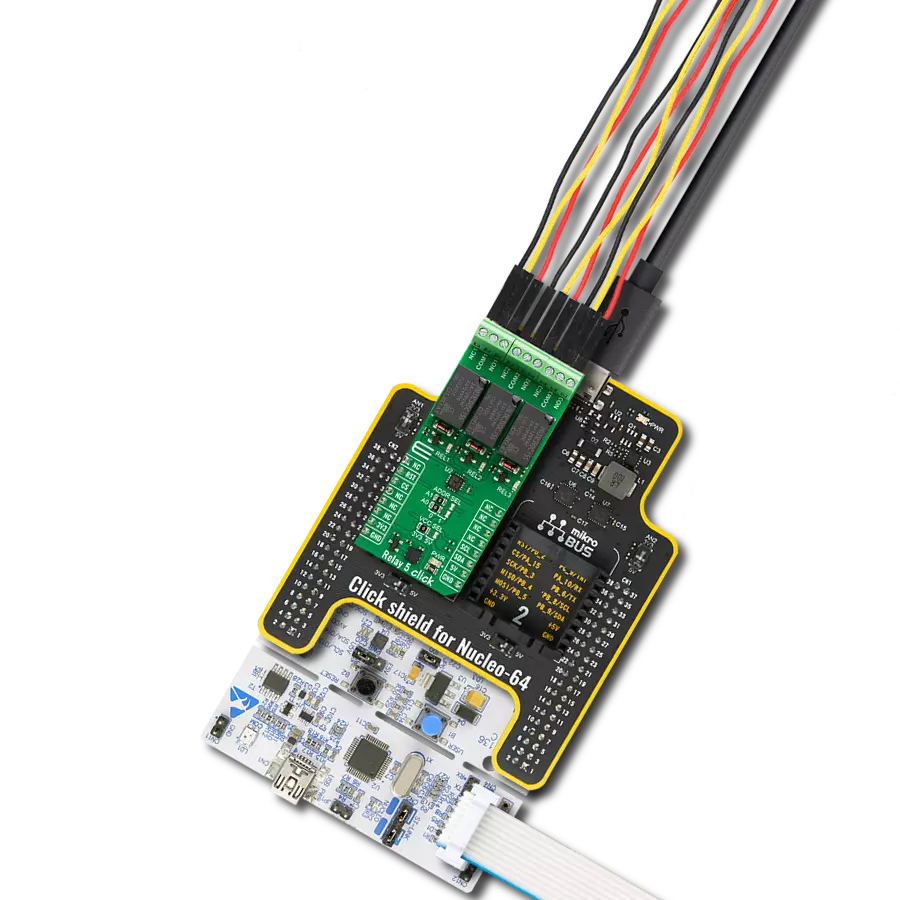Manage loads reliably with advanced protection and diagnostics, ideal for replacing relays and fuses in automotive and industrial systems
A
A
Hardware Overview
How does it work?
SolidSwitch 8 Click is based on the BTS3035EJXUMA1, a single-channel smart low-side power switch from Infineon. This 35mΩ device uses an advanced N-channel vertical power MOSFET design, which is monolithically integrated, ensuring high reliability and compactness. Engineered with automotive-grade quality, the BTS3035EJXUMA1 is ideal for robust 12V automotive applications. Still, it can manage a versatile range of load types - including resistive, inductive, and capacitive loads - with a maximum voltage range from 6V to 18V and load currents up to 5A. This Click board™ offers a practical solution for controlling loads with varying characteristics and can replace traditional electromechanical relays, fuses, and discrete circuits in numerous applications. Its design enables reliable switching and precise load management, making it suitable for high-efficiency automotive and industrial
systems. The BTS3035EJXUMA1 has comprehensive protection features, enhancing its reliability across various applications. These include an overtemperature shutdown with automatic restart, active clamp overvoltage protection, and current limitation, all safeguarding the device under demanding operating conditions. Additionally, it has a low output leakage current when in the OFF state, electrostatic discharge (ESD) protection, and full AEC-Q100 qualification, ensuring resilience in automotive environments. SolidSwitch 8 Click establishes its connection with the host MCU through specific pins on the mikroBUS™ socket, which controls the operation of the onboard BTS3035EJXUMA1 IC. The IN pin is the TTL logic control signal, where a HIGH logic level enables the smart power switch to manage its load. Additionally, the STS pin functions as an open-drain feedback status output, providing real-
time monitoring and alerting the MCU in case of detected anomalies, such as an overtemperature condition. For immediate visual feedback, the onboard ERR red LED indicates any detected operational anomaly controlled through the ERR pin on the mikroBUS™ socket. This LED activation provides an accessible visual alert for users, enhancing diagnostics and safety by signaling issues directly on the board. This Click board™ can operate with either 3.3V or 5V logic voltage levels selected via the VIO SEL jumper. This way, both 3.3V and 5V capable MCUs can use the communication lines properly. Also, this Click board™ comes equipped with a library containing easy-to-use functions and an example code that can be used as a reference for further development.
Features overview
Development board
Curiosity PIC32 MZ EF development board is a fully integrated 32-bit development platform featuring the high-performance PIC32MZ EF Series (PIC32MZ2048EFM) that has a 2MB Flash, 512KB RAM, integrated FPU, Crypto accelerator, and excellent connectivity options. It includes an integrated programmer and debugger, requiring no additional hardware. Users can expand
functionality through MIKROE mikroBUS™ Click™ adapter boards, add Ethernet connectivity with the Microchip PHY daughter board, add WiFi connectivity capability using the Microchip expansions boards, and add audio input and output capability with Microchip audio daughter boards. These boards are fully integrated into PIC32’s powerful software framework, MPLAB Harmony,
which provides a flexible and modular interface to application development a rich set of inter-operable software stacks (TCP-IP, USB), and easy-to-use features. The Curiosity PIC32 MZ EF development board offers expansion capabilities making it an excellent choice for a rapid prototyping board in Connectivity, IOT, and general-purpose applications.
Microcontroller Overview
MCU Card / MCU
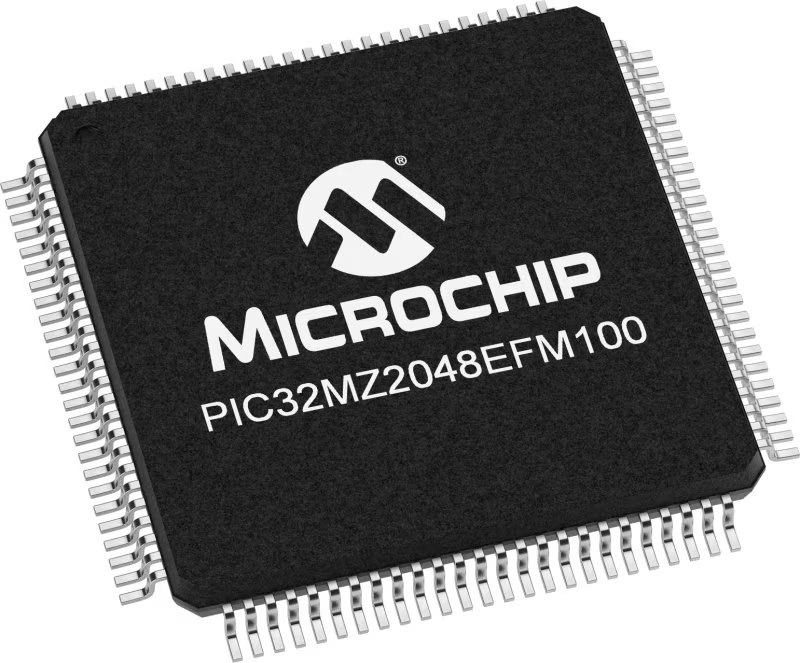
Architecture
PIC32
MCU Memory (KB)
2048
Silicon Vendor
Microchip
Pin count
100
RAM (Bytes)
524288
Used MCU Pins
mikroBUS™ mapper
Take a closer look
Click board™ Schematic
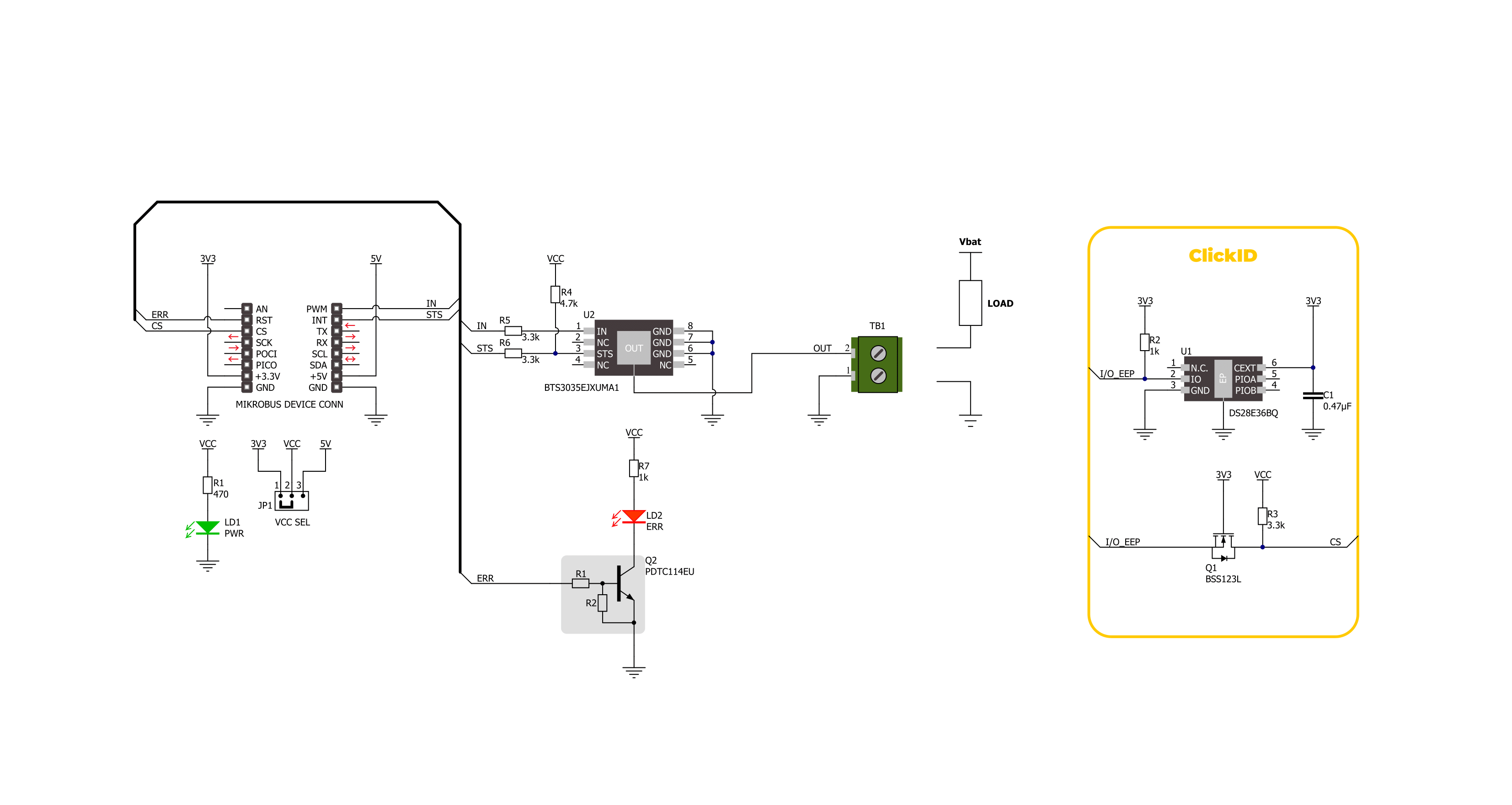
Step by step
Project assembly
Track your results in real time
Application Output
1. Application Output - In Debug mode, the 'Application Output' window enables real-time data monitoring, offering direct insight into execution results. Ensure proper data display by configuring the environment correctly using the provided tutorial.

2. UART Terminal - Use the UART Terminal to monitor data transmission via a USB to UART converter, allowing direct communication between the Click board™ and your development system. Configure the baud rate and other serial settings according to your project's requirements to ensure proper functionality. For step-by-step setup instructions, refer to the provided tutorial.

3. Plot Output - The Plot feature offers a powerful way to visualize real-time sensor data, enabling trend analysis, debugging, and comparison of multiple data points. To set it up correctly, follow the provided tutorial, which includes a step-by-step example of using the Plot feature to display Click board™ readings. To use the Plot feature in your code, use the function: plot(*insert_graph_name*, variable_name);. This is a general format, and it is up to the user to replace 'insert_graph_name' with the actual graph name and 'variable_name' with the parameter to be displayed.

Software Support
Library Description
This library contains API for SolidSwitch 8 Click driver.
Key functions:
solidswitch8_set_err_pin- This function sets the err pin state to the selected level of SolidSwitch 8 Click.solidswitch8_set_in_pin- This function sets the in pin state to the selected level of SolidSwitch 8 Click.solidswitch8_get_sts_pin- This function reads the state of the status pin of SolidSwitch 8 Click.
Open Source
Code example
The complete application code and a ready-to-use project are available through the NECTO Studio Package Manager for direct installation in the NECTO Studio. The application code can also be found on the MIKROE GitHub account.
/*!
* @file main.c
* @brief SolidSwitch 8 Click Example.
*
* # Description
* This example demonstrates the use of SolidSwitch 8 Click board by
* switching state of the switch.
*
* The demo application is composed of two sections :
*
* ## Application Init
* Initializes the driver, performs the Click default configuration.
*
* ## Application Task
* Switching state of the output every 5 seconds,
* and monitoring the status of the device.
*
* @author Stefan Ilic
*
*/
#include "board.h"
#include "log.h"
#include "solidswitch8.h"
static solidswitch8_t solidswitch8; /**< SolidSwitch 8 Click driver object. */
static log_t logger; /**< Logger object. */
void application_init ( void )
{
log_cfg_t log_cfg; /**< Logger config object. */
solidswitch8_cfg_t solidswitch8_cfg; /**< Click config object. */
/**
* Logger initialization.
* Default baud rate: 115200
* Default log level: LOG_LEVEL_DEBUG
* @note If USB_UART_RX and USB_UART_TX
* are defined as HAL_PIN_NC, you will
* need to define them manually for log to work.
* See @b LOG_MAP_USB_UART macro definition for detailed explanation.
*/
LOG_MAP_USB_UART( log_cfg );
log_init( &logger, &log_cfg );
log_info( &logger, " Application Init " );
// Click initialization.
solidswitch8_cfg_setup( &solidswitch8_cfg );
SOLIDSWITCH8_MAP_MIKROBUS( solidswitch8_cfg, MIKROBUS_1 );
if ( DIGITAL_OUT_UNSUPPORTED_PIN == solidswitch8_init( &solidswitch8, &solidswitch8_cfg ) )
{
log_error( &logger, " Communication init." );
for ( ; ; );
}
solidswitch8_default_cfg ( &solidswitch8 );
log_info( &logger, " Application Task " );
}
void application_task ( void )
{
if ( SOLIDSWITCH8_PIN_STATE_LOW == solidswitch8_get_sts_pin( &solidswitch8 ) )
{
solidswitch8_set_err_pin( &solidswitch8, SOLIDSWITCH8_PIN_STATE_HIGH );
log_error( &logger, " Detected over temperature condition." );
for ( ; ; );
}
log_printf( &logger, " Switch state closed. \r\n" );
solidswitch8_set_in_pin( &solidswitch8, SOLIDSWITCH8_PIN_STATE_HIGH );
Delay_ms ( 1000 );
Delay_ms ( 1000 );
Delay_ms ( 1000 );
Delay_ms ( 1000 );
Delay_ms ( 1000 );
log_printf( &logger, " Switch state open. \r\n" );
solidswitch8_set_in_pin( &solidswitch8, SOLIDSWITCH8_PIN_STATE_LOW );
Delay_ms ( 1000 );
Delay_ms ( 1000 );
Delay_ms ( 1000 );
Delay_ms ( 1000 );
Delay_ms ( 1000 );
}
int main ( void )
{
/* Do not remove this line or clock might not be set correctly. */
#ifdef PREINIT_SUPPORTED
preinit();
#endif
application_init( );
for ( ; ; )
{
application_task( );
}
return 0;
}
// ------------------------------------------------------------------------ END




















